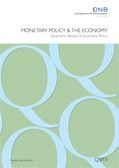Monetary Policy and the Economy Q3/22
 OeNB
OeNB
- published:
- November 2022
 OeNB
OeNB
Monetary Policy and the Economy Q3/22 (PDF, 1.7 MB) November 2022
Austrian economy to slow down after strong first half (PDF, 596 kB) Fritzer, Schneider, Sellner, Stiglbauer, Vondra. In the second half of 2022, the war in Ukraine and ensuing high inflation are set to deal a major blow to Austria’s economy. In the first half, robust economic growth was still carried by consumers’ pent-up demand and strong exports. As a result, economic growth will still come to about 5% in 2022 as a whole. Yet, in the summer, first signs of a trend reversal became evident in the Austrian labor market. Unemployment rates are already edging up, starting from lower levels than before the COVID-19 pandemic, and the number of people in employment and vacancies are edging down. HICP inflation had increased sharply since the beginning of the year, but in August lower fuel prices caused it to move sideways. For the rest of the year, inflation is, however, expected to remain high. en Nov 23, 2022, 12:00:00 AM
Nontechnical summaries (in English and German) (PDF, 128 kB) de en Nov 23, 2022, 12:00:00 AM
What is the impact of carbon pricing on inflation in Austria? (PDF, 766 kB) Breitenfellner, Fritzer, Prammer, Rumler, Salish. Tackling the climate crisis is one of the biggest challenges of our times with major repercussions for the macroeconomy. This study focuses on the impact of setting a price for carbon on consumer price inflation. Carbon pricing is a cost-effective means to reduce greenhouse gas emissions and incentivize sustainable behavior by increasing the prices of fossil fuels. To assess the related inflationary risk, we elaborate on two complementary (explicit) pricing approaches – carbon taxation and emissions trading – in the EU and in Austria. After teething problems, the emissions trading system launched by the EU in 2005 turned into an effective tool of decarbonization, with roughly 30% of EU-wide emissions cut by 2020 as emission allowance prices were raised over time. In Austria, rising allowance prices did not have a significant impact on inflation given the high share of renewable sources in power generation. With regard to the carbon tax that Austria will apply in the course of 2022 to sectors not covered by emissions trading, we estimate HICP inflation to go up by 0.1 to 0.2 percentage points annually until 2025, excluding indirect and second-round effects. Looking forward, trends in climate change and low-carbon transition may further impact inflation, its volatility and its distributional consequence and pose a challenge for monetary and other policies alike. This, however, should not detract from necessary climate protection in view of the consequences of unmitigated climate change on inflation and human activity at large. en climate change, carbon pricing, inflation, monetary policy E31, H23, Q54 Nov 23, 2022, 12:00:00 AM
Where have all the insolvencies gone?
(PDF, 428 kB)
Elsinger, Fessler, Kerbl, Schneider, Schürz, Wiesinger, Wuggenig.
Like in many other industrialized countries, government support programs kept corporate insolvency rates below pre-crisis levels in Austria in 2020 and 2021, and continued to do so in 2022 in all months for which data were available at the time of writing (up to July 2022). From information available to the OeNB, we built a firm-level database to examine whether the lower rates of insolvencies were offset by higher rates of firms exiting the market without insolvency and/or lower rates of firms entering the market. We find the number of firm exits without insolvency to have gone down as well, whereas firm entries remained rather stable in 2020 and increased markedly in 2021.
On the assumption that the pandemic support payments were designed to keep vulnerable firms in business, our corporate balance sheet data suggest that the support was lavish and probably not targeted enough. To further substantiate our findings, we cross-check our database with the European Commission’s state aid transparency database. The evidence at hand suggests that a rather large share of the public support payments ultimately appears to have increased firms’ deposits, respectively their liquidity buffers, in a highly uncertain environment, and even equity, rather than having to be spent to keep businesses afloat. With the benefit of hindsight, government support provided in 2020 can, therefore, to a large extent be interpreted as compensation for losses due to state-imposed lockdowns or public transfers to equity holders for the build-up of risk buffers. Put differently, the full extent of government support does not seem to have been crucial for keeping firms in existence.
Looking ahead, more transparency with regard to firm-level pandemic support payments is a necessary precondition for gaining a deeper understanding of the impact of public support on the structure of the business sector and corporate balance sheets, competition, innovation and financial stability. These insights could help in improving measures for current and future crises.
en
firms, insolvencies, COVID-19, firm entries, firm exits, policy evaluation, government subsidies
L11, L25, H32, H25, G33, G38
Nov 23, 2022, 12:00:00 AM
The return of inflation (PDF, 216 kB) Gnan, Messner, Rieder, Rumler, Salish. Key findings from the 49th OeNB Economics Conference and the 35th SUERF Colloquium (May 23/24, 2022) en Nov 23, 2022, 12:00:00 AM